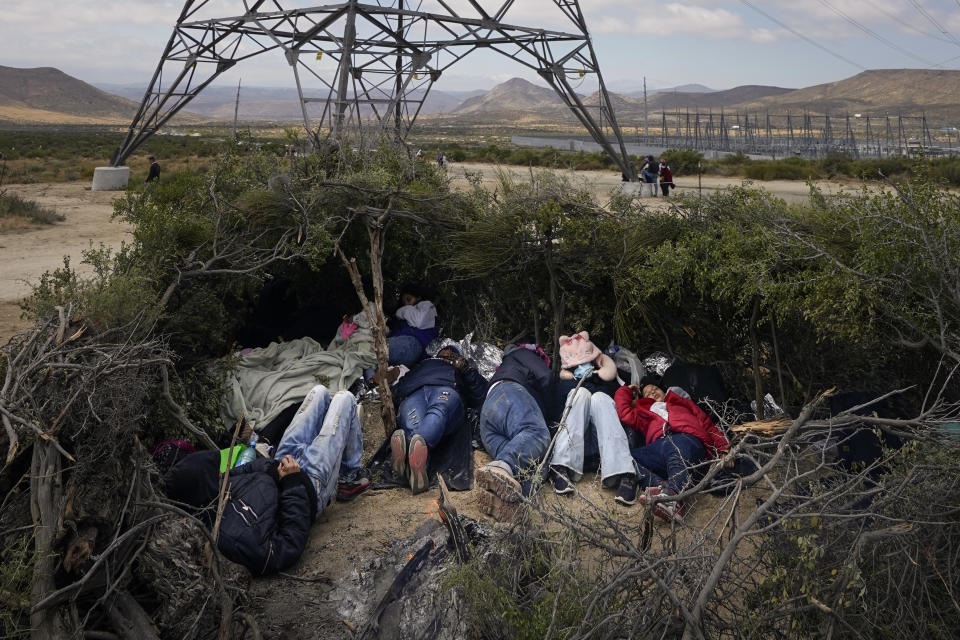Associated Press images of migrants' struggle are recognized with a Pulitzer Prize
NEW YORK (AP) — The images, captured by Associated Press photographers throughout 2023 and recognized Monday with a Pulitzer Prize, spotlight the humanity of an unprecedented global migration story often overlooked in a storm of statistics and political rhetoric.
In the middle of the Central American jungle, a woman fleeing upheaval in her native Haiti struggles to cross a river while holding a girl on her shoulders. After weeks of desperation, migrants pass a toddler under a tangle of concertina wire strung across the edge of U.S. soil.
Well before the year began, AP’s journalists knew that surging migration through the Americas was a major story. But to tell it fully, they focused on showing that "migration is more than numbers. It has to do with people, with the stories behind the reasons for them to leave their countries,” said Eduardo Castillo, AP’s news director for Latin America and the Caribbean.
On Monday, eight AP staff and freelance photographers – six from Latin America and two from the U.S. – were awarded this year’s Pulitzer for feature photography for images documenting the anxiety, heartbreak and even the brief moments of joy that mark the migrants' journey.
“Simply put, this was AP at its best – leveraging our global footprint and deep expertise to cover a fast-moving story with high impact,” Executive Editor Julie Pace said in a note sent to the news staff Monday. “It’s also particularly heartening that the Pulitzers have recognized AP’s work on international migration given that this has been a global coverage priority for us for the past several years.”
The AP was also a Pulitzer finalist in 2019 for its coverage of family separation during the Trump administration.
While the award came in the feature category, the work was all part of everyday news coverage, Castillo said. The images, he said, are a testament to efforts by the journalists — staff photographers Greg Bull, Eric Gay, Fernando Llano, Marco Ugarte and Eduardo Verdugo, and longtime AP freelance photographers Christian Chavez, Felix Marquez and Ivan Valencia — to connect with migrants.
“I'd just like to thank people on the way, the migrants themselves ... the folks who allowed us to be with them in this tense moment of their life and allowed us, entrusted us to tell their stories,” Bull said in remarks to other AP staffers shortly after the award was announced.
The photos reflect a recognition by the AP that surging migration was drawing increased attention from the public and policymakers, and warranted increased coverage. Taking advantage of its staffing throughout Latin America and along the U.S.-Mexico border, the news agency assigned journalists to document the poverty, violence, persecution and natural disasters that are driving the surge of departures and shaping the migrants’ path.
The result was a series of “poignant photographs chronicling unprecedented masses of migrants in their arduous journey north,” Pulitzer Administrator Marjorie Miller said in announcing the award.
The photos were taken at several pivotal moments, including the end of pandemic-era restrictions last May that had allowed the U.S. to quickly turn away migrants and a large increase in border arrivals last September that overwhelmed immigration authorities and communities.
The U.S. alone has seen more than 10 million migrants arrive at its borders over the last five years. Many come from countries including Venezuela and Ecuador that had not been large drivers of immigration in earlier years.
The photographers worked to show how many of those migrants embark on their journey through the Darien Gap, the dense and roadless jungle that stands between South and Central America.
Other images show migrants crowded onto a northbound freight train in the middle of a Mexican night as it winds toward the U.S. border, and others in a makeshift camp of brush and branches near the U.S. border.
In totality, they show one of the biggest stories of our time, requiring the AP photographers spread across multiple countries to work with both great diligence and empathy, said Ricardo Mazalán, Latin America deputy director of storytelling and photos.
“It was their ability to emotionally grasp the experience of others and connect with the migrants," Mazalán said, “that enabled them to convey the profoundly intimate moments they captured.”

















